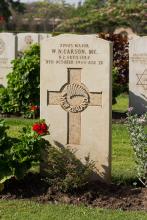All Black No 446. Played 3 games, no tests. Debut against a Combined Western Districts team in Wellington on 20th July 1938.
Bill Carson was honoured in sport as the fifth person to represent New Zealand in both cricket and rugby, and in war as a recipient of the Military Cross for bravery. The son of the Gisborne harbourmaster, Alexander Carson, and his wife, Mabel Alice Scoullar, William Nicol Carson was born in Gisborne on 16 July 1916. He attended Kaiti School from 1921 to 1928, captaining the First XI cricket team in 1928, and Gisborne High School from 1929 to 1933, where he played in the First XI and First XV. At 15 years of age he made his first representative cricket appearance, as a left-handed batsman for Poverty Bay. On matriculating from high school in late 1933 he was employed as a warehouseman by Sargood, Son and Ewen in Auckland.
After some minor matches with the Auckland cricket side and five games of rugby for the Ponsonby District Rugby Football Club, he made his début in first-class rugby for Auckland against Waikato in 1936. He played at lock, before becoming a flanker. He was named one of the Rugby Almanack of New Zealand ’s five promising players from the 1936 season.
In the 1936–37 cricket season he was selected for Auckland’s southern tour. During his second first-class game, against Otago at the Carisbrook ground, he was sent in to bat with Auckland at 25 for 2. Untroubled by a polished Otago attack, he posted his century in 136 minutes, and then took another 74 minutes to reach 200 runs. The final 90 runs of his innings took 58 minutes. His score of 290 was 2 runs short of Victor Trumper’s record of 292 not out as the highest maiden century in world first-class cricket. He shared another world record with Paul Whitelaw by adding 445 runs for the third wicket.
When he backed that effort with 194 runs in 214 minutes against Wellington, his selection for the national team to tour England in 1937 was a mere formality. However, Carson struggled on the slower wickets. According to English cricket identity Sir Pelham Warner, he developed a fault with deliveries on his leg stump and went out several times playing weak shots. He scored only 627 runs on the tour, at an average of 19 per innings.
On his return to New Zealand he scored another century against Otago before preparing for the 1938 rugby season. He was selected for the All Blacks’ tour of Australia, but an ankle injury confined him to three minor games. Although he made only one Plunket Shield appearance in the summer of 1938–39, he scored another century playing cricket against Wellington. Consequently, he was named in the New Zealand team to play the XI selected by Sir Julien Cahn of Britain. After a full season of rugby in 1939 he was regarded as a certainty for the All Blacks’ 1940 tour of South Africa. The team was never named.
With the outbreak of the Second World War Bill Carson was posted to the 6th Field Regiment of the New Zealand Artillery on 1 February 1940. He married Marie Patricia Jeffries at Remuera on 13 August 1940, and sailed for North Africa with the 4th Reinforcements on 19 December. Initially a second lieutenant, he rose to be captain. Carson served in Crete, where he was injured in the famous charge to re-take Galatos. He later rejoined his unit in North Africa, serving with distinction. At Sidi Rezegh his artillery battery held off a dozen enemy tanks for two days. His unit was often assigned to special duties and his troop was sent to support the 1st King’s Dragoon Guards, an armoured car unit doing reconnaisance for the New Zealand Corps, during the chase after Field Marshal Erwin Rommel’s retreating Afrika Korps. He was awarded the Military Cross for quickly positioning his guns to fire accurately against two well-equipped Italian battalions at the battle of Mareth in 1943. Major General H. K. Kippenberger, who had encountered Carson at various stages of the war, said of him: ‘How often other commanders had cause to be grateful for his skill and boldness and his sportsman’s sense of anticipation I do not know, but there were many times’.
After the North African campaign Carson was posted to Italy. He was serving in the 5th Field Regiment as acting major when, on 29 July 1944, at San Michele, near Florence, he suffered extensive wounds to his lungs, liver, thigh and ankle. Twice classified as ‘seriously ill’, he recovered and was readied for travel by hospital ship back to New Zealand. However, while waiting at Bari he contracted jaundice and failed to respond to treatment. He died on 8 October on board the ship and was buried at Heliopolis Military Cemetery, Cairo, Egypt.
This biography was written by Lynn McConnell and was first published in the
Dictionary of New Zealand Biography.




